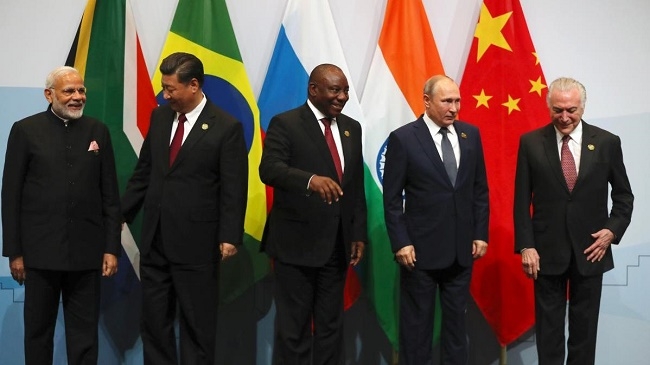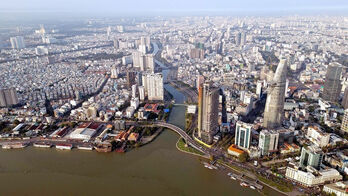
The leaders of BRICS member countries pose for a group picture at the BRICS summit meeting in Johannesburg, South Africa, July 26, 2018. (Photo: Reuters)
This is the first meeting of BRICS since US President Donald Trump launched a campaign to rebalance trade multilateralism, which triggered unilateralism policies and protectionism, while directly affecting many BRICS members. Therefore, the risk of a global trade war was a “hot” topic discussed at the conference.
Under the theme “BRICS in Africa: Collaboration for Inclusive Growth and Shared Prosperity in the fourth Industrial Revolution (Industry 4.0)”, the 2018 BRICS Summit draws attention because it touches on Industry 4.0, which has had a strong impact on the socio-economic development of many countries. South Africa, the rotating chair of BRICS, has expressed its ambition to capitalise on the role of an equal member in BRICS to promote the interests of the “black continent”.
Africa has still yet to be able to make use of its advantage as a resource-rich region and Industry 4.0 can provide the continent with a “key” to tap into the potential, as well as respond to challenges. Facilitating the development of Africa also offers many opportunities for the BRICS members not only to show their leading role but also to accelerate cooperation with such a high potential continent.
Taking place amid the emergency risks posed by the US-led unilateral policy, the summit is an opportunity for the BRICS members to set aside their differences in terms of interests and focus on discussing and analysing the impacts and how to deal with common concerns as the BRICS members are subjected to the US’s extreme trade protectionism policy. As the global economic sphere will face a major change if the risk of international trade confrontation is not extinguished, there needs to be a consensus among BRICS countries to work out appropriate solutions.
According to Kenneth Creamer, an economist at Johannesburg’s Wits University, trade agreements between associations of countries, such as the BRICS, are becoming increasingly important, as the US wishes to create trade barriers. In fact, the BRICS countries have yet to reach an effective and unified cooperation mechanism that will help to increase the bloc’s influence in the international community. Thus, the US’s new trade policy is likely to motivate BRICS to form a more unified front in response to new challenges.
With its increasingly affirmed role and position, BRICS is pursuing its ambition to become a locomotive, even a “counterweight” to other institutions, such as the G7 or the G20. Following BRICS’s expansion and cooperation motivation after the ninth summit in 2017, this year’s conference is expected to approve the “BRICS +” cooperation model, with the participation of representatives from developing countries, while holding many discussions between the BRICS and African leaders.
BRICS countries expect the bloc to emerge as a representative of developing countries, while further strengthening the south-south cooperation. As protectionism is making it unlikely for the world to have a unified commercial space, the expansion of BRICS can help to create a broader market with stronger links.
Following over ten years of development, BRICS is demonstrating its crucial position as the bloc accounts for up to 43% of the global population and represents more than half of the world’s economic growth. One of the messages given by the BRICS countries is the protection of multilateralism and the improvement of global governance. However, the conference also offers an ideal opportunity for BRICS members, especially those that are in the eye of the trade dispute storm with the US, such as China and Russia, to coordinate with the bloc’s other countries in the search for measures to avoid the occurrence of a trade war that could possibly harm all parties. The solidarity of the BRICS member states is essential in order to fight protectionism, while affirming the bloc’s role and influence towards mutual cooperation and development./.
NDO
 Southeast Asia’s digital economy to top 300 billion USD by end 2025
Southeast Asia’s digital economy to top 300 billion USD by end 2025



